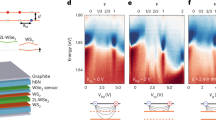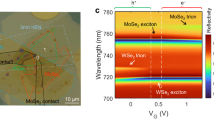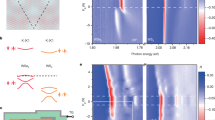Abstract
Strongly correlated quantum particles in lattice potentials are the building blocks for a wide variety of quantum insulators—for instance, Mott phases and density waves breaking lattice symmetry1,2,3. Such collective states are accessible to bosonic and fermionic systems2,4,5,6,7,8,9,10,11,12. To expand further the spectrum of accessible quantum matter phases, mixing both species is theoretically appealing because density order then competes with phase separation13,14,15,16. Here we manipulate such a Bose–Fermi mixture by confining neutral (boson-like) and charged (fermion-like) dipolar excitons in an artificial square lattice of a GaAs bilayer. At unitary lattice filling, strong inter- and intraspecies interactions stabilize insulating phases when the fraction of charged excitons is around (1/3, 1/2, 2/3). We evidence that dual Bose–Fermi density waves are then realized, with species ordered in alternating stripes. Our observations highlight that dipolar excitons allow for controlled implementations of Bose–Fermi Hubbard models extended by off-site interactions.
This is a preview of subscription content, access via your institution
Access options
Access Nature and 54 other Nature Portfolio journals
Get Nature+, our best-value online-access subscription
$29.99 / 30 days
cancel any time
Subscribe to this journal
Receive 12 print issues and online access
$259.00 per year
only $21.58 per issue
Buy this article
- Purchase on Springer Link
- Instant access to full article PDF
Prices may be subject to local taxes which are calculated during checkout



Similar content being viewed by others
Data availability
Source data are available for download, together with the published manuscript.
References
Salomon, C., Shlyapnikov, G. V. & Cugliandolo, L. F. Many-Body Physics with Ultracold Gases (Oxford Univ. Press, 2012).
Arovas, D. P., Berg, E., Kivelson, S. A. & and Raghu, S. The Hubbard Model. Annu. Rev. Condens. Matter Phys. https://doi.org/10.1146/annurev-conmatphys-031620-102024 (2022).
Fradkin, E., Kivelson, S. A. & Tranquada, J. M. Colloquium: theory of intertwined orders in high temperature superconductors. Rev. Mod. Phys. 87, 457 (2015).
Greiner, M., Mandel, O., Esslinger, T., Haensch, T. W. & Bloch, I. Quantum phase transition from a superfluid to a Mott insulator in a gas of ultracold atoms. Nature 415, 39–44 (2002).
Gemelke, N., Zhang, X., Hung, C. L. & Chin, C. In situ observation of incompressible Mott-insulating domains in ultracold atomic gases. Nature 460, 995–998 (2009).
Li, H. et al. Imaging two-dimensional generalized Wigner crystals. Nature 597, 650–654 (2021).
Regan, E. C. et al. Mott and generalized Wigner crystal states in WSe2/WS2 moiré superlattices. Nature 579, 359–363 (2020).
Huang, X. et al. Correlated insulating states at fractional fillings of the WS2/WSe2 moiré‚ lattice. Nat. Phys. 17, 715–719 (2021).
Xu, Y. et al. Correlated insulating states at fractional fillings of moiré superlattices. Nature 587, 214–218 (2020).
Jin, C. et al. Stripe phases in WSe2/WS2 moiré‚ superlattices. Nat. Mater. 20, 940–944 (2021).
Lagoin, C., Suffit, S., Baldwin, K., Pfeiffer, L. & Dubin, F. Mott insulator of strongly interacting two-dimensional excitons. Nat. Phys. 18, 149–153 (2022).
Lagoin, C. et al. Extended Bose-Hubbard model with dipolar excitons. Nature 609, 485–489 (2022).
Büchler, H. P. & Blatter, G. Supersolid versus phase separation in atomic Bose-Fermi mixtures. Phys. Rev. Lett. 91, 130404 (2003).
Lewenstein, M., Santos, L., Baranov, M. A. & Fehmann, H. Atomic Bose-Fermi mixtures in an optical lattice. Phys. Rev. Lett. 92, 050401 (2004).
Titvinidze, I., Snoek, M. & Hofstetter, W. Supersolid Bose-Fermi mixtures in optical lattices. Phys. Rev. Lett. 100, 100401 (2008).
Sugawa, S. et al. Interaction and filling-induced quantum phases of dual Mott insulators of bosons and fermions. Nat. Phys. 7, 642–648 (2011).
Combescot, M., Combescot, R. & Dubin, F. Bose-Einstein condensation of indirect excitons: a review. Rep. Prog. Phys. 80, 066401 (2017).
Remeika, M., Fogler, M. M., Butov, L. V., Hanson, M. & Gossard, A. C. Two-dimensional electrostatic lattices for indirect excitons. Appl. Phys. Lett. 100, 061103 (2012).
Lagoin, C. et al. Microscopic lattice for two-dimensional dipolar excitons. Phys. Rev. B 102, 245428 (2020).
Baranov, M. A., Dalmonte, M., Pupillo, G. & Zoller, P. Condensed matter theory of dipolar quantum gases. Chem. Rev. 112, 5012–5061 (2012).
Dutta, O. et al. Non-standard Hubbard models in optical lattices: a review. Rep. Prog. Phys. 78, 066001 (2015).
Beian, M. et al. Spectroscopic signatures for the dark Bose-Einstein condensation of spatially indirect excitons. Europhys. Lett. 119, 37004 (2017).
Dietl, S. et al. On the parabolicity of dipolar exciton traps and their population of excess charge carriers. New J. Phys. 21, 063028 (2019).
Misra, S. et al. The role of spin-flip collisions in a dark-exciton condensate. Proc. Natl Acad. Soc. USA 119, e2203531119 (2022).
Sergeev, R. & Suris, R. A. The X+ trion in a system with spatial separation of the charge carriers. Semiconductors 37, 1205–1210 (2003).
Witham, O., Hunt, R. J. & Drummond, N. D. Stability of trions in coupled quantum wells modeled by two-dimensional bilayers. Phys. Rev. B 97, 075424 (2018).
Chung, Y. J. et al. Ultra-high-quality two-dimensional electron systems. Nat. Mater. 20, 632–637 (2021).
Kowalik Seidel, K. et al. Tunable photo-emission from an excitonic anti-trap. Nano Lett. 12, 326–330 (2012).
Rapaport, R. & Chen, G. Experimental methods and analysis of cold and dense dipolar exciton fluids. J. Phys. Condens. Matter 19, 295207 (2007).
Schmid, G., Todo, S., Troyer, M. & Dorneich, A. Finite-temperature phase diagram of hard-core Bosons in two dimensions. Phys. Rev. Lett. 88, 167208 (2002).
Acknowledgements
Research at CNRS (C.L. and F.D.) has been financially supported by IXTASE from the French Agency for Research (no. ANR-20-CE30-0032-01). The work at Princeton University (L.P. and K.B.) was funded in part by the Gordon and Betty Moore Foundation’s EPiQS Initiative (grant no. GBMF9615 to L.P.) and by the National Science Foundation MRSEC (grant no. DMR 2011750) to Princeton University.
Author information
Authors and Affiliations
Contributions
K.B. and L.P. realized the GaAs bilayer while C.L., S.S. and F.D. fabricated the gate electrodes imprinting the 250-nm-period electrostatic lattice. C.L. and F.D. performed all experiments and data analysis and wrote the manuscript. F.D. designed the project.
Corresponding author
Ethics declarations
Competing interests
The authors declare no competing interests.
Peer review
Peer review information
Nature Materials thanks David Ruiz-Tijerina and the other, anonymous, reviewer(s) for their contribution to the peer review of this work.
Additional information
Publisher’s note Springer Nature remains neutral with regard to jurisdictional claims in published maps and institutional affiliations.
Extended data
Extended Data Fig. 1 Lattice filling vs. gate voltage.
a Total integrated intensities of the PL radiated by neutral and charged excitons, as a function of Vg and at unitary filling (P=14 nW). b Same experimental results as in a but expressed as a function of νCX. c Scaling of νCX as a function of Vg deduced from the measurements shown in a and b. The line provides a guide for the eyes. Experiments were all realised at 330 mK and acquired during four different experimental runs so that detection efficiencies are close but not identical. Vertical error bars display the poissonian precision in a-b and the ± 0.03 precision on νCX in c. In a-c, the horizontal error is smaller than the points size while in b it corresponds to the precision when extracting νCX.
Extended Data Fig. 2 Evaluation of the residual doping level.
PL spectrum radiated by neutral dipolar excitons for νX ≈ 1/2 (at νCX ≈ 0). The spectrum is measured by averaging 10 realisations performed under unchanged conditions. The profile is given by our spectral resolution, that is reproduced by a single lorentzian-like line with around 150 μeV full-width-at-half-maximum (blue area and black line). Measurements were performed at 330 mK, error bars displaying the level of poissonian fluctuations.
Extended Data Fig. 3 Thermal melting of CX insulators at νCX = 1/2 and 1.
a Compressibility κCX normalised to the level given by poissonian noise for (νCX = 1/2, νX ≈ 0) as a function of the bath temperature. b Identical measurements for (νCX = 1, νX ≈ 0) . While in a the thermal melting of the insulating phase occurs around 1K, as expected for the magnitude measured for VCX,CX, a similar critical temperature is found in b for the Mott phase. This possibly reflects fluctuations of the density of injected holes while the bath temperature is increased. For all measurements error bars mark our statistical precision when computing the compressibility ( ± 0.03).
Extended Data Fig. 4 Interaction energies and spatial ordering.
Possible configurations of incompressible phases made by neutral (blue) and charged (red) excitons. The respective energy shifts of PL energies, EX and ECX, are indicated below each configuration together with the resulting magnitude of ΔEX,CX, by only taking into account NN interactions.
Source data
Rights and permissions
Springer Nature or its licensor (e.g. a society or other partner) holds exclusive rights to this article under a publishing agreement with the author(s) or other rightsholder(s); author self-archiving of the accepted manuscript version of this article is solely governed by the terms of such publishing agreement and applicable law.
About this article
Cite this article
Lagoin, C., Suffit, S., Baldwin, K. et al. Dual-density waves with neutral and charged dipolar excitons of GaAs bilayers. Nat. Mater. 22, 170–174 (2023). https://doi.org/10.1038/s41563-022-01409-9
Received:
Accepted:
Published:
Issue Date:
DOI: https://doi.org/10.1038/s41563-022-01409-9
This article is cited by
-
Bose–Fermi mixtures in 2D solid-state superstructures
Nature Materials (2023)



